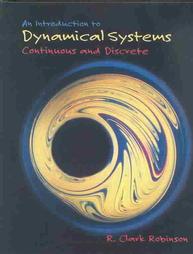 |
An Introduction to Dynamical Systems:
Continuous and Discrete
Clark Robinson
Prentice Hall (2004), 672 pp., price $80.- ISBN: 0131431404
|
| Reviewer: Todd Young, Department of Mathematics, Ohio University,
Athens OH, USA |
The book is an introduction to dynamical systems, primarily intended as a
textbook for an advanced undergraduate course. As the title suggests, the book
covers both continuous and discrete dynamical systems.
It is surprising to me that discrete and continuous parts of the book are
completely segregated. The first part is about nonlinear differential equations
and the second part covers iteration of functions. This is in contrast to other
introductory dynamics books, such as [1,2,4,5,6,7], that treat discrete
and continuous systems in a more integrated fashion. Other
textbooks such as [3,8] treat only discrete or
continuous dynamical systems: this is the first to the reviewer's
knowledge that treats both in a fully separate manner. The author states in
the Preface that the parts can be covered in either order.
The biggest problem I see with this approach is that the connections
between the two parts might not be as clear as they should be.
The second thing that strikes me about the book after the arrangement of topics,
is the thoroughness of the treatment. The book not only covers a wide variety of
topics, but for each of these topics the author presents concepts, methods,
applications and proofs. In fact, if the book has a fault it might be that it
covers too much; those interested in a mathematical approach might be put off by
the extensive treatment of applications and the introduction of concepts through
examples, while those interested in an applied approach might be equally
dissatisfied with the large number of definitions, theorems and proofs in the
book.
The author attempts to avoid the later problem by placing the harder proofs in
separate sections titled ``Theory and Proofs'' at the end of each chapter.
However, the main text is still rich in rigorous mathematics. Given this, the
book may become the choice for those who want their students to be well-grounded
in both worlds.
The book begins with a historical prologue and an introduction to the
``Geometric Approach to Differential Equations'', which is in fact a very brief
overview of Part I of the book. Part I consists of the following chapters:
2. Linear Systems
3. The Flow: Solutions of Nonlinear Equations
4. Phase Portraits with an Emphasis on Fixed Points
5. Phase Portraits Using Energy and Other Test Functions
6. Periodic Orbits
7. Chaotic Attractors
The second part of the book begins with an introduction to discrete dynamical
systems. Chapter titles include:
9. One-Dimensional Maps
10. Itineraries for One-Dimensional Maps,
11. Invariant Sets
12. Higher Dimensional Maps
13. Invariant Sets for Higher Dimensional Maps
14. Fractals
For example, the third chapter begins with the logistic equation followed by
an explanation that we might not be able to find explicit solutions for
nonlinear equations. It proceeds with the traditional existence, uniqueness and
differential dependence on initial conditions theorem, the proof of which is
postponed until the ``Theory and Proof'' section. Examples of nonexistence and
non-uniqueness are presented. It then covers the definition of the flow defined
by the equation, the group property of the flow, the definition of periodic
orbits and invariant sets and the first variation equation. Then the author
introduces the Euler, Improved
Euler (Heun), and Runga-Kutta methods, followed by a treatment of local and
global errors. This is followed by the example of the Euler method applied to
the harmonic oscillator and a brief discussion of more advanced numerical
methods. The Theory and Proofs section of this chapter introduces the Lipschitz
condition,
the Picard iteration scheme, Gronwall's inequality, complete proofs of the
claims about existence, uniqueness and continuous dependence on initial
conditions and an explanation of how the first variation equation gives
differential dependence. The section concludes with theorems and proofs about
the order of the local and global errors of the Euler and Heun methods. All the
chapters contain a similar mixture of example, theory and application. At the
end of each chapter are a wide variety of well written exercises, including
proofs, derivations, numerical
simulations and applications.
In summary I think that this book would be an excellent text for a one year
sequence for advanced undergraduates in math or beginning graduate students in
engineering or the sciences. Personally, I would advise the instructor to be
careful to make connections between discrete and continuous parts.
1. K. Alligood, T. Sauer, and J. Yorke, Chaos: An Introduction to
Dynamical Systems, Texts in Mathematical Sciences, Springer-Verlag, New
York, 1997.
2. D. Arrowsmith and C. Place, An Introduction to Dynamical Systems,
Cambridge University Press, 1990.
3. R. Devaney, An Introduction to Chaotic Dynamical Systems, Westview
Press, 2nd edition, 2003.
4. J. Hale and J. Kocak, Dynamics and Bifurcations, Texts in Applied
Mathematics, vol. 3, Springer-Verlag, New York, 1991.
5. B. Hasselblatt and A. Katok, A First Course in Dynamics: with a Panorama
of Recent Developments, Cambridge University Press, 2003.
6. R. Hilborn, Chaos and Nonlinear Dynamics: An Introduction for Scientists
and Engineers, Oxford University Press; 2nd edition, 2001.
7. D. Kaplan and L. Glass, Understanding Nonlinear Dynamics, Springer-Verlag,
New York, 1995.
8. L. Perko, Differential Equations and Dynamical Systems, Texts in
Applied Mathematics, vol. 7, Springer-Verlag, New York; 3rd edition, 2001.